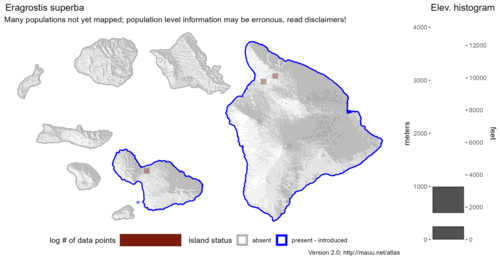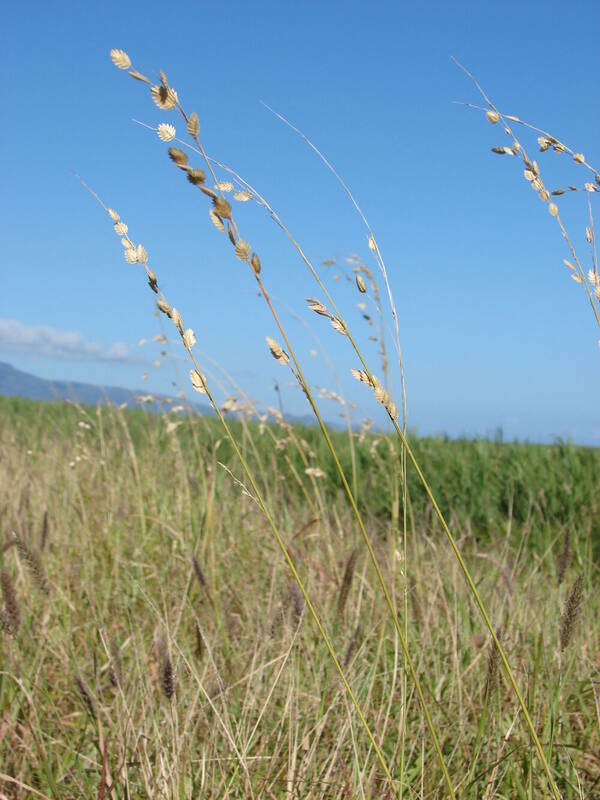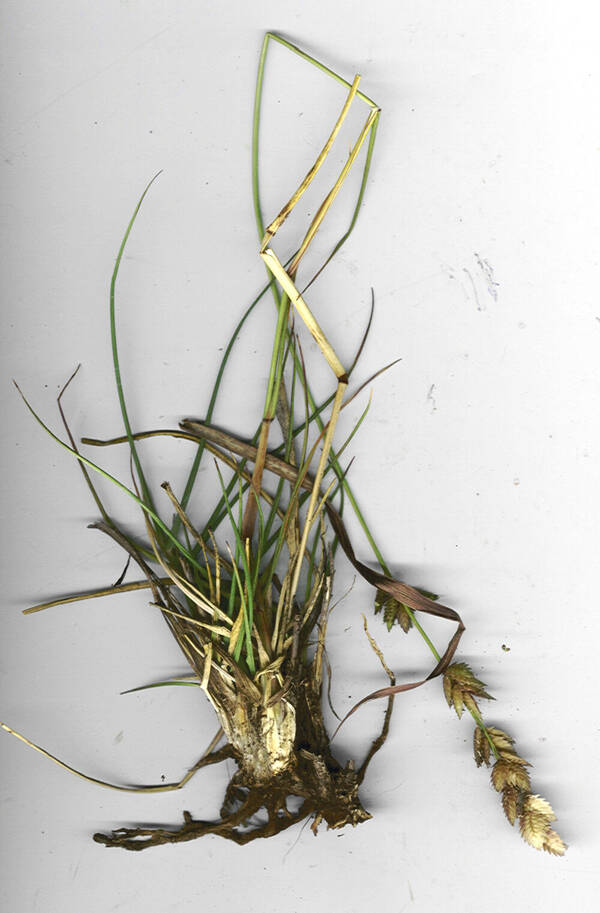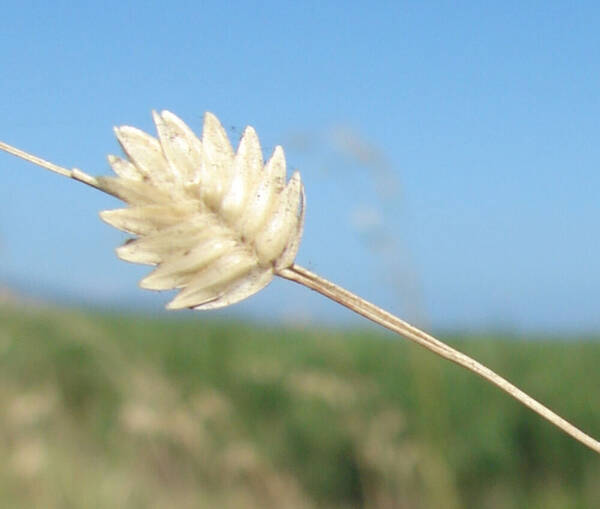Info
Subfamily: Chloridoideae
Genus etymology: Eragrostis = "love grass" [Greek] unclear origin, other etymologies such as "early grass" or "very grass" have also been speculated
Species etymology: superba = "extra" [Latin] refering to the large spikelets
Photosynthetic type: C4 (warm season)
Nativity: naturalized - intentional
First recorded in Hawaiʻi: 1985
Map

Inflorescence

Plant

Spikelets

Description
Caespitose perennial; culms 20–120 cm. high, erect. Leaf-blades flat, up to 40 cm. long and 10 mm. wide, firm, glaucous. Panicle lanceolate to broadly ovate, 10–30 cm. long; primary branches stout, usually with secondary branchlets but sometimes almost raceme-like, the spikelets on short pedicels 1–5 mm. long. Spikelets 6–28(–47)-flowered, narrowly ovate to suborbicular, 6–16(–23) mm. long, 3–10 mm. wide, strongly flattened, green tinged with brownish purple, disarticulating below the glumes at maturity and falling entire; glumes lanceolate in side view, subequal, 2–4 mm. long; lemma narrowly ovate in side view, 3–4.5 mm. long, strongly keeled, the keel scaberulous, narrowly obtuse; palea 2-nerved, the nerves thickened, cartilaginous, and bearing a hyaline minutely ciliolate wing; anthers 3, 2 mm. long. Caryopsis ellipsoid, 1–1.5 mm. long. Fig. 61/9, p. 193.
(Description source: Clayton, W.D. 1970. Flora of Tropical East Africa. Gramineae (Part 1). Crown Agents for Oversea Governments and Administrations, London. 176 pp. )
Caespitose perennial without rhizomes or stolons; culms up to 120(200) cm tall, erect, often branched above, glabrous at the nodes, eglandular; basal leaf sheaths glabrous, chartaceous to subcoriaceous, terete, eglandular, persistent; ligule a line of hairs; leaf laminas up to 40 cm × 3–12 mm, linear, flat, glabrous, firm and somewhat glaucous, eglandular.Panicle 10–30 cm long, lanceolate to broadly ovate, the spikelets evenly distributed or somewhat fascicled on stout pedicels 1–5 mm long, the primary branches stout, secondarily branched or sometimes raceme-like, not in whorls, terminating in a fertile spikelet, glabrous in the axils, eglandular.Spikelets 6–16(23) × 3–10 mm, narrowly ovate to suborbicular, strongly laterally compressed, 6–28(47)-flowered, disarticulating below the glumes and falling entire; glumes subequal, 2–4 mm long, reaching to just beyond the middle of the adjacent lemmas, keeled, lanceolate in profile, glabrous, subacute at the apex; lemmas 3–4.5 mm long, keeled, narrowly ovate in profile, subcoriaceous with conspicuous lateral nerves, diverging from the rhachilla at c. 45° but those in opposite rows imbricate and concealing the rhachilla, green tinged with brownish-purple, scaberulous on the keel, narrowly obtuse at the apex; palea glabrous on the flanks, the keels thickened and cartilaginous, winged throughout, gibbously so below, the wing protruding from the sides of the lemma, the wing margin entire and minutely ciliolate; anthers 3, 1.5–2.5 mm long.Caryopsis 1–1.5 mm long, elliptic.
(Description source: Pope, G.V. (ed). 1999. Flora Zambesiaca. Volume 10. Part 2. Kew, London. 261 pp. )
Plants perennial; cespitose, with innovations, without glands. Culms 45-95 cm, erect, glabrous. Sheaths hairy at the apices and on the margins, hairs to 6 mm; ligules 0.5-1.2 mm; blades 7-30 cm long, 2.5-7 mm wide, flat to loosely involute, glabrous abaxially, scabrous adaxially, margins sharply scabrous. Panicles 10-30 cm long, 1-6 cm wide, oblong, condensed, interrupted below; primary branches 1-11 cm, appressed or diverging to 40° from the rachises, naked basally; pulvini glabrous; pedicels 0.5-25 mm, with a narrow band or abscission line below the apices. Spikelets 5.5-16 mm long, 2.7-9 mm wide, ovate, flattened, greenish to stramineous, some¬times with a reddish-purple tinge, with 4-22 florets; disarticulation below the glumes, spikelets falling intact. Glumes equal, 3-4.5 mm, ovate, chartaceous; lemmas 3-5 mm, broadly lanceolate, chartaceous to leathery, lateral veins green, apices acute; paleas 3-5 mm, chartaceous to hyaline, keels broadly winged below, forming a wing or tooth on each side that often projects beyond the lemma bases, apices acuminate; anthers 3, 1.4-2.8 mm, golden-yellow. Caryopses 1-2 mm, ellipsoid, adaxial surfaces flattened, reddish-brown. 2n = 40.
(Description source: Barkworth, M.E., Capels, K.M., Long, S. & Piep, M.B. (eds.) 2003. Flora of North America, north of Mexico. Volume 25. Magnoliophyta: Commelinidae (in part): Poaceae, Part 2. Oxford University Press, New York. 783 pp. http://floranorthamerica.org/Eragrostis_superba )